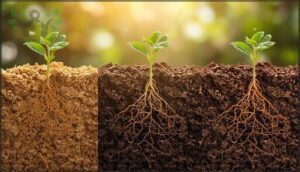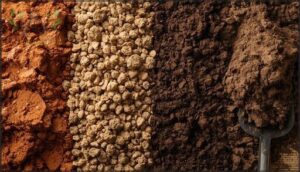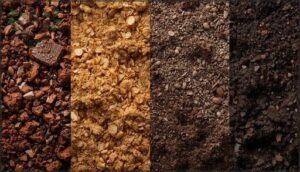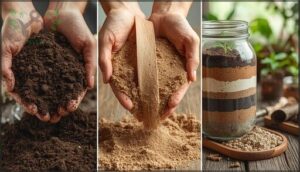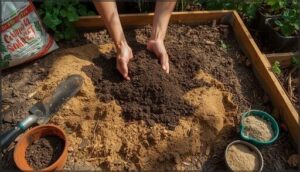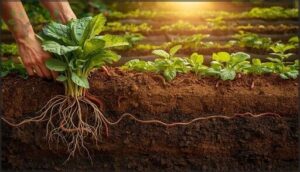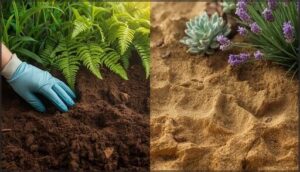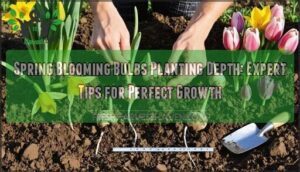This site is supported by our readers. We may earn a commission, at no cost to you, if you purchase through links.
The difference between a thriving garden and a struggling one often comes down to what’s happening beneath the surface. Many gardeners spend hours selecting the perfect plants and following watering schedules, only to watch their efforts falter because they’ve overlooked the foundation of it all: the soil itself.
Understanding soil composition for gardening isn’t just about knowing whether you have clay or sand—it’s about recognizing how minerals, organic matter, water, and air work together to create an environment where roots can spread, nutrients can flow, and plants can flourish.
When you grasp what makes your soil tick, you gain the ability to work with it rather than against it, transforming even challenging ground into productive garden space.
Table Of Contents
- Key Takeaways
- What Makes Up Garden Soil?
- How Soil Texture Affects Gardening
- Types of Garden Soils Explained
- Soil PH and Nutrient Availability
- Role of Organic Matter in Soil Health
- Amending Soil for Better Composition
- Water Management and Soil Composition
- Soil Conservation and Sustainable Practices
- Selecting Plants for Your Soil Type
- Frequently Asked Questions (FAQs)
- Conclusion
Key Takeaways
- Your soil’s texture—the ratio of sand, silt, and clay—controls how water drains, how roots spread, and whether nutrients stick around or wash away, making it the foundation that determines which plants will thrive or struggle in your garden.
- Soil pH acts as a gatekeeper between 6.0 and 7.5, unlocking nutrient availability for most plants, but extreme levels either starve roots of essentials or trigger aluminum toxicity that damages growth despite regular fertilizing.
- Adding just 1% more organic matter can hold an extra 16,500 gallons of water per acre while releasing 20–30 pounds of nitrogen annually, transforming poor soil into a self-sustaining system that feeds plants and supports beneficial microorganisms.
- Matching your plant selection to your existing soil type—rather than fighting it—cuts root disease by 30% and boosts yields by 20%, while simple amendments like compost or mulch can bridge the gap when your dream crops need different conditions.
What Makes Up Garden Soil?
Garden soil isn’t just dirt—it’s a living, breathing system made up of several key ingredients working together. Each component plays a specific role in supporting plant roots, storing nutrients, and managing water.
Let’s break down the three essential elements that form the foundation of healthy garden soil.
Mineral Components—sand, Silt, Clay
At the foundation of your garden, three mineral particles shape everything your plants experience. Understanding their differences helps you work with your soil’s strengths rather than against them.
- Sand (0.05–2 mm): Drains quickly, warms fast in spring, but struggles with nutrient retention
- Silt (0.002–0.05 mm): Balances moisture and fertility, though it compacts easily
- Clay (under 0.002 mm): Holds water and nutrients tightly, providing excellent soil strength but slow water drainage
These proportions determine your soil texture and composition. Understanding your soil type is key, as soil management practices impact overall soil health.
Organic Matter and Its Sources
While mineral particles provide structure, organic matter breathes life into your soil. Think of it as your garden’s energy source—living organisms, decomposing residues, and stable humus working together.
Here’s what you can add:
| Source | Primary Benefit |
|---|---|
| Compost | Balanced nutrients, improved structure |
| Animal manures | Quick nutrient boost, microbial activity |
| Cover crops | Erosion control, nitrogen fixation |
| Biochar | Long-term carbon storage, moisture retention |
Most garden soils contain just 2-3% organic matter, but 5-10% encourages healthier growth. To maintain soil fertility, consider an annual addition of composted organic matter.
Water and Air in Soil Structure
Beyond the solid particles you’ve added, roughly half your garden’s soil volume is empty—pore spaces that house water and air. These voids aren’t just gaps; they’re lifelines. About 25–30% should hold water for roots, while 20–25% needs air for respiration.
When waterlogged soil fills every pore, drainage impacts become severe: roots suffocate, microbes struggle, and plants wilt despite abundant moisture.
How Soil Texture Affects Gardening
Soil texture isn’t just a technical term—it’s the key to understanding how your garden will perform. The way sand, silt, and clay particles come together determines everything from how roots spread to whether your plants thrive or struggle.
Let’s break down what soil texture really means and why it matters so much for your gardening success.
Defining Soil Texture
Soil texture describes how much sand, silt, and clay you’ve got in your garden. Think of it as your soil’s personality. The USDA classes help you pinpoint your soil type using a texture triangle, or you can try the feel method—just rub moist soil between your fingers.
These particle size differences determine key soil properties like drainage and nutrient storage, shaping what’ll thrive in your loam.
Soil Texture and Plant Root Growth
When your soil’s too compacted, plant roots struggle to push through—root elongation slows, and root diameter shrinks. Clayey soils often suffocate roots with poor soil aeration, while sandy soil offers easier root development but may lack nutrient availability.
Soil compaction above certain thresholds can reduce root length by 30–46%, directly impacting how well your plants access what they need to thrive.
Influence on Water Retention and Drainage
When you’re choosing plants or planning irrigation, soil texture makes all the difference. Sandy soils drain fast—retaining just 0.25 to 0.75 inches of water per foot—while silt loam can hold 2.00 to 2.50 inches, striking a sweet spot for most gardens.
Adding organic matter boosts water retention dramatically: every 1% increase holds about 20,000 extra gallons per acre, influencing how your soil composition fosters healthy growth.
Types of Garden Soils Explained
Not all garden soils are created equal, and knowing what you’re working with can save you a lot of headaches down the road. Each soil type has its own personality—some hold water like a sponge, while others let it slip through like sand in an hourglass.
Let’s break down the main players so you can figure out exactly what’s in your garden beds.
Characteristics of Clay, Sand, Silt, and Loam
Each soil texture brings its own personality to your garden. Here’s what sets them apart:
- Clay soils have tiny particles that create clay compaction issues, holding water tightly but draining slowly—often staying wet for days.
- Sand features large particles allowing excellent sand drainage, though it dries out quickly and needs frequent watering.
- Silt offers moderate silt fertility with a smooth texture that retains moisture better than sand.
- Loam provides ideal loam balance, combining all three particles for superb soil texture.
Advantages and Disadvantages of Each Type
No single soil texture dominates your garden without trade-offs. Clay soil benefits include excellent nutrient retention and water-holding capacity, yet clayey soils struggle with compaction and poor drainage. Sandy soil issues center on rapid moisture loss despite quick warming and easy tilling. Silt soil fertility shines with natural richness, though erosion threatens unprotected beds. Loamy soil balance delivers versatility across most plants, making soil amendment needs minimal compared to other soil types.
| Soil Type | Key Advantages | Main Drawbacks |
|---|---|---|
| Clay | Holds nutrients and water exceptionally well; provides stable root support | Compacts easily; drains poorly, risking waterlogging |
| Sandy Soil | Warms quickly in spring; resists compaction; excellent drainage | Requires frequent watering and fertilizing; poor nutrient retention |
| Silt | Naturally fertile; balances moisture retention with drainage | Prone to erosion and compaction when wet |
| Loam | Choice soil texture combining drainage and fertility; easiest to work | May support too many plant options, complicating selection |
Identifying Your Soil Type at Home
You don’t need fancy equipment to identify your soil type at home. Start with the Ribbon Test: moisten a handful of soil, then squeeze and roll it between your fingers. If it forms a smooth ribbon over two inches, you’ve got clay. Crumbly texture? That’s sand.
For accuracy, combine this Hand Feel method with the Jar Test—shake soil and water in a clear jar, let it settle for 24 hours, and measure the distinct layers of sand, silt, and clay from bottom to top. Visual Indicators like color also help: darker soils generally contain more organic matter.
Running Multiple Tests ensures you won’t misclassify your soil texture, which directly affects your watering and fertilizing plans. Professional Soil testing methods provide the most precise results, but these simple approaches give you solid baseline information for smarter gardening decisions.
Soil PH and Nutrient Availability
Your soil’s pH is like a gatekeeper that decides which nutrients your plants can actually use. Even if your soil is packed with minerals, the wrong pH can lock them away from your plants’ roots, leaving you scratching your head over poor growth.
Soil pH acts as a gatekeeper, controlling which nutrients your plants can actually absorb—even in mineral-rich soil
Let’s look at why pH matters so much and how you can adjust it to realize your soil’s full potential.
Importance of Soil PH for Plants
Think of pH levels as the dial controlling your garden’s health—it’s that important. Soil testing reveals where you stand, and here’s what you need to know:
- Ideal ranges between 6.0 and 7.5 boost nutrient solubility for most plants
- Low soil pH levels trigger aluminum toxicity that damages roots
- Microbial activity thrives in neutral to slightly acidic conditions
- Nutrient availability peaks when pH adjustment brings soils into proper balance
- Extreme pH levels reduce beneficial soil organisms
How PH Affects Nutrient Uptake
Soil pH acts like a gatekeeper for nutrient availability—and it’s more powerful than you might think. Between pH 6.0 and 7.0, your plants can access nitrogen, phosphorus, and potassium most efficiently. Outside this range, micronutrient solubility shifts dramatically.
In acidic conditions below 5.5, iron and manganese become overly available while aluminum reaches toxic levels, damaging root function and limiting nutrient uptake despite regular amendments.
Adjusting Soil PH for Optimal Growth
Fortunately, you can shift pH where it needs to be. Lime application raises acidic soils—50 to 150 grams per square meter nudges pH up by 0.5 to 1.0 units in four to twelve weeks.
For alkaline ground, sulfur amendments work in reverse, dropping pH over six to ten weeks.
Soil testing before and after amendments keeps nutrient availability on track for acid-loving plants and most vegetables alike.
Role of Organic Matter in Soil Health
Organic matter is the unsung hero of healthy soil, doing everything from holding moisture to feeding plants. It transforms heavy clay into workable ground and turns sandy soil into something that actually holds water and nutrients.
Let’s look at how organic matter improves your garden, where to find it, and the tiny but mighty organisms it nourishes.
Benefits for Structure and Fertility
When you boost organic matter in your garden, you’re investing in both soil structure and fertility. Each 1% increase can hold up to 16,500 more gallons of water per acre while releasing nutrients steadily—around 20–30 lbs of nitrogen annually.
Better aggregate stability means less erosion and improved aeration, creating the perfect environment for healthy nutrient cycling and thriving soil organisms.
Sources of Organic Matter (compost, Manure, Etc.)
You’ve got plenty of organic amendments to choose from. Compost composition includes about 33–50% active decomposing materials plus stable humus—perfect for long-term soil fertility. Manure application adds nitrogen and phosphorus, though only 8% of U.S. cropland uses it.
Don’t overlook yard trimmings, straw, or even root contribution from cover crops, which decompose slowly and build persistent organic matter.
Supporting Beneficial Soil Organisms
When you add organic amendments like compost, you’re feeding beneficial microorganisms that drive nutrient cycling in your soil ecosystem. These tiny workers—bacteria, fungi, and archaea—make up your soil’s microbial diversity and transform raw materials into plant-available nutrients.
Reduced tillage protects this soil biodiversity, while regular soil testing helps you monitor how well your soil biology is thriving.
Amending Soil for Better Composition
If your soil isn’t quite right, don’t worry—there are practical ways to improve it. Small changes can make a big difference in how your plants grow.
Here’s how you can amend your soil for better results.
Incorporating Compost and Organic Materials
Think of compost as your soil’s best friend. Incorporating compost and organic matter boosts soil structure, increases water retention by up to 80–90%, and replenishes essential nutrients like nitrogen and phosphorus.
Kitchen scraps, shredded leaves, and well-rotted manure become powerful soil amendments through composting. This eco-gardening practice aids beneficial microbes, reduces your need for synthetic organic fertilizers, and transforms waste recycling into thriving soil health.
Improving Drainage and Aeration
When you loosen compacted soil to a depth of 8–12 inches, you’re giving roots better access to oxygen and water. Mixing in rice hulls or pumice boosts porosity enhancement and water infiltration.
Raised beds with drainage systems or a layer of round gravel reduce waterlogging.
These practical steps improve soil aeration, drainage, and overall soil structure for healthier plants.
Addressing Common Soil Deficiencies
Nitrogen deficiency shows up as yellowing leaves, while phosphorus uptake slows when pH strays from 6.0–7.5. Soil testing pinpoints what’s missing so you can apply targeted soil amendments.
Here’s how to tackle nutrient deficiencies:
- Add compost or manure for nitrogen, waiting four months before harvest
- Adjust pH to improve micronutrient availability and potassium leaching in sandy soils
- Rotate legumes to boost organic matter addition naturally
Water Management and Soil Composition
Your soil’s texture doesn’t just determine what grows well—it also shapes how you water. Clay holds moisture like a sponge, while sand lets it slip right through, and each type demands a different approach to keep plants thriving without drowning or drying out.
Let’s look at how soil composition affects your watering strategy and what you can do to get it right.
How Soil Type Influences Watering Needs
Your soil type dictates watering practices more than you might think. Sandy soils drain quickly, needing irrigation two to three times weekly with small amounts—around 0.3 to 0.5 inches each session. Loamy or clay soils hold moisture longer, requiring just one deep watering per week at roughly 1.0 inch. Understanding soil texture, water availability, and root depth ensures efficient water management and healthier plants.
| Soil Type | Irrigation Frequency |
|---|---|
| Coarse sand | 3 times weekly |
| Sandy loam | 2 times weekly |
| Loam | Once weekly |
| Clay | Once weekly |
Preventing Waterlogging and Drought Stress
Balancing extremes protects your garden from both waterlogging and drought stress. Improve drainage solutions with organic amendments—compost boosts water retention during dry spells and infiltration by up to 50% in soggy conditions. Raised beds lift roots above saturated zones, cutting waterlogging incidents by 70%.
Monitor moisture levels regularly and choose drought-tolerant plants for vulnerable areas. Proper water management keeps roots healthy year-round.
Techniques for Efficient Irrigation
Once you’ve tackled waterlogging and drought, smart irrigation systems take water management to the next level. Drip irrigation delivers up to 90% efficiency by targeting roots directly, slashing consumption by 20–50% compared to sprinklers.
Add mulch benefits like reduced evaporation, or try subsurface methods in windy spots. Pairing these techniques with drought-tolerant plants optimizes water retention and keeps your garden thriving year-round.
Soil Conservation and Sustainable Practices
Healthy soil doesn’t just happen—it takes thoughtful care to keep it productive season after season. The good news is that a few smart practices can protect your garden soil from erosion, nutrient loss, and degradation while building long-term fertility.
Let’s look at three key strategies that’ll help you garden in harmony with nature.
Preventing Erosion in The Garden
When rain hammers down on bare ground, you’re watching topsoil disappear—the U.S. loses over 2 billion tons yearly. Mulching slashes erosion by more than 50%, while vegetative barriers and terracing methods control runoff reduction effectively.
Adding mulch after storms, planting dense grasses perpendicular to slopes, and maintaining year-round soil cover are your best defenses for soil stabilization and erosion control in any garden.
Crop Rotation and Cover Cropping
Beyond stopping erosion, you can rebuild your garden’s foundation through crop rotation and cover crops. Rotating vegetables breaks pest cycles—reducing pest populations by 24% to 34%—while boosting yields by an average of 20%. Cover crops like crimson clover add organic matter and cut costs.
Here’s your rotation strategy:
- Switch plant families annually to disrupt pest management patterns
- Include legumes for natural soil fertility enhancement
- Plant cover crops between main seasons for soil biodiversity
- Track rotation benefits through improved yield stability over time
Mulching and Reduced Tillage Methods
Mulching locks in 25% more moisture while slashing weeds by up to 90%—that’s fewer herbicides and less watering. You’ll also protect against erosion and feed soil microbes. Pair it with reduced tillage to boost microbial carbon by 50% in topsoil, support carbon sequestration, and improve yield stability. Together, these gardening practices strengthen organic matter and long-term soil health.
| Practice | Key Benefit |
|---|---|
| Mulching | Water retention, erosion prevention |
| Reduced Tillage | Soil microbes, carbon sequestration |
| Combined | Yield stability, soil conservation |
Selecting Plants for Your Soil Type
Once you understand what type of soil you’re working with, the next step is choosing plants that will actually thrive in those conditions. Some plants love clay’s moisture retention, while others need sandy soil’s quick drainage to stay healthy.
Let’s look at how to match your plants to your soil, adjust things when needed, and plan a garden layout that sets you up for success.
Matching Plant Preferences to Soil Conditions
Matching plants to your soil’s texture needs, pH preferences, and nutrient requirements isn’t just smart—it’s the foundation of gardening success. When there’s a health mismatch between plant selection and soil type, growth rates plummet and root development suffers. Here’s what thrives where:
- Loamy soils: Over 70% of garden vegetables prefer this balanced mix
- Sandy loam: Carrots show 40% less root deformity here
- Acidic soils (pH 4.5–5.5): Blueberries need this for iron uptake
- Well-draining loam: Tomatoes and peppers cut root disease by 30%
- Alkaline soils (pH 7.0–8.0): Lavender and thyme flourish
Understanding your plant community’s preferences prevents the frustration of watching crops struggle in unsuitable conditions.
Adapting Soil for Specific Crops or Flowers
Once you know what thrives in your soil type, you can fine-tune conditions through targeted soil amendments. Adjusting soil pH with sulfur or lime shifts nutrient availability for acid-loving blueberries or alkaline-preferring asparagus. Texture adjustment matters too—mixing compost into clay improves drainage for waterlogging-sensitive broccoli, while organic matter helps sandy soils retain moisture for strawberries.
Soil testing reveals nutrient levels, guiding phosphorus supplements for root crops like carrots or potassium additions for tomatoes. Water management strategies, from drip irrigation in sand to raised beds in clay, complete your crop-specific adaptations.
| Crop Type | Soil Amendments Needed | Key Adjustments |
|---|---|---|
| Blueberries | Sulfur, peat moss | Lower pH to 4.5-5.5 |
| Tomatoes | Compost, potassium | Improve drainage, boost fruit quality |
| Carrots | Rock phosphate | Strengthen root development |
| Broccoli | Organic matter | Fix clay drainage issues |
Planning Successful Garden Layouts
With your soil composition and plant selection dialed in, you’re ready to translate that knowledge into a productive layout. Sunlight orientation anchors every decision—position taller crops on north edges to prevent shading shorter plants.
Space maximization through raised beds and companion planting boosts yields while improving soil texture and drainage:
- Use intensive plant spacing for 30–60% more produce
- Apply relay planting to grow 25% extra crops per bed
- Pair compatible species to boost soil health indicators
Frequently Asked Questions (FAQs)
How does soil temperature affect seed germination rates?
Ever wonder why your seeds sprout fast one week but stubbornly wait the next? Soil temperature directly controls germination rates—warmer conditions within the ideal soil moisture and temperature range accelerate seedling emergence, while cooler temperatures delay plant growth substantially.
What role do earthworms play in soil composition?
You’ll find these garden heroes transform soil composition by creating worm casts packed with nutrients, improving soil aeration through tunneling, and speeding up decomposition rates while enhancing soil structure for healthier plant growth.
Can contaminated soil be safely remediated for gardening?
Yes, contaminated soil can be remediated through phytoremediation efficacy, soil amendments, sophisticated technologies, and exposure reduction. Soil testing identifies contaminants, enabling risk assessment and targeted soil improvement, making gardening practices safer and more sustainable.
How often should established gardens be soil tested?
Testing frequency factors like soil type influence how often you need a soil test. Generally, every 3 to 5 years works well, though sandy soils or amendment impact may require more frequent nutrient levels checks.
What causes soil compaction and how to prevent it?
Soil compaction happens when heavy machinery, excessive tillage, or high moisture levels squeeze soil particles together.
Prevention methods include limiting traffic on wet soil, adding organic matter, using mulch, and practicing no-till gardening to maintain soil structure and aeration.
Conclusion
Studies show that healthy soil contains over one billion microorganisms per teaspoon—a thriving underground city working for your garden’s success. Understanding soil composition for gardening gives you the power to support this hidden ecosystem and create conditions where plants truly thrive.
With each amendment you add and every practice you improve, you’re not just growing plants—you’re building living soil that will reward your efforts season after season.
- https://extension.uga.edu/
- https://hort.caes.uga.edu/people/faculty/robert-westerfield.html
- https://www.extension.purdue.edu/extmedia/HO/HO-287-W.pdf
- https://www.agweb.com/news/crops/crop-production/soil-air-and-water-unite
- https://www.sare.org/publications/building-soils-for-better-crops/soil-particles-water-and-air/


